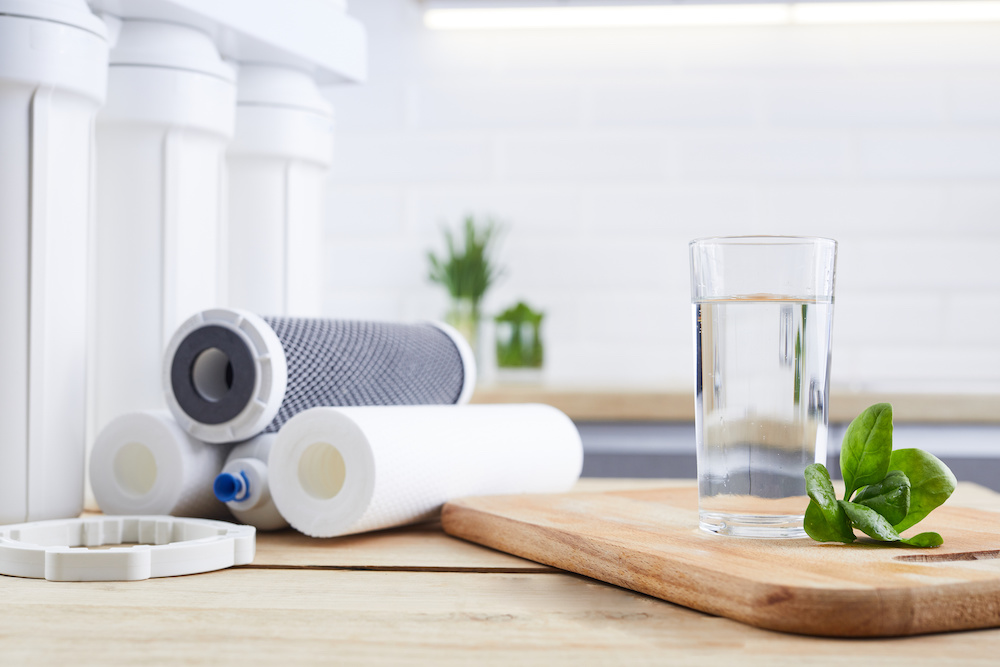While we technically have vast amounts of water, not all are safe for human consumption.
Fortunately, we developed technologies to process water, making it drinkable and safe for general use.
Such technology is the water filtration system, which, according to a 2022 survey, 77% of Americans use.
However, a question may be on your mind now: which should I choose between 3 stage water filter vs reverse osmosis?
Today, we will discuss how these two filtration processes compare and help you choose which suits you better.
3 Stage Water Filters Explained
A 3 stage water filter is a multi-layered filtration system that typically uses a filter or cartridge for each stage.
These filters are sediment, carbon, and another sediment or carbon filter with lower micron ratings.
Your unfiltered water first goes through the sediment filter, the first purification stage in the system.
It helps remove the bad taste and improve the appearance of your water by removing sediment and other particle matter, including grit, silt, and rust.
Typically, your stage one sediment filters should be rated 50 microns or finer to filter sediments properly. This is to protect your carbon filter from bigger filter contaminants that might get stuck.
Next, water goes to the second stage, the carbon filter. This stage uses granulated activated carbon to condition the water and remove chlorine and chloramines before the last filtering stage.
It also removes poor taste and odor from hydrogen sulfide. Essentially, carbon filters do this through a process called adsorption (not to be confused with absorption).
Adsorption happens when an adsorbent (activated carbon) binds atoms, ions, or molecules from adsorbates (gas, liquid, or dissolved solid contaminants).
After this, the third stage could be another sediment or carbon filter with finer pores.
Pros
The top benefits of 3 stage water filter are as follows:
- Affordable Options Available
On average, you can expect to pay around $50 or more for a point-of-use 3 stage water filter depending on the brand and filtration mechanisms.
Typically, filters with lower micron ratings will cost higher since they have better filtering capabilities.
Fortunately, a wide range of options will allow flexibility in terms of budget.
- Easily Installed
Most point-of-use 3-stage water filters are also easy to install. Usually, it will only take 30 minutes, a pair of pliers, and a screwdriver to set up.
You can also find many installation tutorial videos online since it’s a common filtration system used worldwide.
- Excellent Filtration Capabilities
A 3 stage water filter can better remove your water’s harmful contaminants than a single filter system.
That is because they can focus on filtering broader categories of substances for each cartridge stage.
It means that by installing a high-quality 3 stage filter system, you can ease your mind better about hidden toxins and other pollutants harming your and your family’s health.
Cons
Some drawbacks that you need to keep in mind when deciding to purchase or use a 3 stage water filter are:
- High Maintenance Cost
One disadvantage of a 3 stage filtration system is its maintenance cost. Although multiple filters can mean safer drinking water, it can also mean multiple regular filter replacements, which can add up over time.
On average, filter cartridges can cost $30 or more, depending on the micron ratings, brand, and composition.
- Low Flow Rate
3 stage water filters have a disadvantage in flow rate because they use three filter cartridges to be more effective.
They impede the system’s ability to flow at applicable rates commonly needed for regular household use and consumption.
Fortunately, reputable companies are upfront about their product’s flow rate in the specs sheet on the packaging or their website, so check that before buying the unit.
- Does Not Remove TDS
Unfiltered water commonly has Total Dissolved Solids (TDS) contaminants, which aren’t always harmful under normal levels.
Some examples of TDS are inorganic salts, such as sodium, calcium, potassium, magnesium, carbonates, and nitrates.
To soften your water and get rid of TDS, you should look at purification systems that include reverse osmosis, deionization, or distillation.

Reverse Osmosis Explained
Let’s first examine what osmosis is to help you understand the reverse osmosis process.
Osmosis is the process of water or other solvents spontaneously passing or diffusing through a semipermeable barrier that prevents the flow of solutes or dissolved compounds.
From this definition, reverse osmosis is a separation method that occurs when an external force applies pressure to a solution.
The solvent is then forced through a semipermeable membrane from one area of low concentration to another, leaving the solutes behind.
In conclusion, fresh water and other small solution components can get across the membrane, while bigger molecules like salts and other contaminants cannot.
Reverse osmosis filters (RO) typically use a multi-layered filtration process to the 3 stage water filters.
However, the last stage in RO systems uses a polymer semipermeable membrane that filters at the molecular level.
The first stages ensure that the polymer membrane won’t be damaged or clogged with bigger contaminants.
With how fine the RO membrane is, it can eliminate virtually everything that a standard filter may be unable to catch. This particular filter will reduce TDS down to 0.0001 microns.
Pores of this size can remove organic compounds and inorganic minerals like parasite cysts, fluoride, calcium, copper, and magnesium.
Pros
Here are two of the top benefits of reverse osmosis:
- Excellent Contaminant Removal
RO is regarded as one of the most effective methods of removing water contaminants.
Standard residential RO systems can effectively remove 99% of 84 different pollutants, including TDS.
RO filters strip water to its most basic molecules using microscopic membranes, leaving impurities trapped and flushed out.
- Acts as Water Softener
Since RO systems can remove TDS from your water supply, your kitchenware will no longer have stains from mineral deposits.
Moreover, whole-house RO systems can prevent water pipe clogging due to hard mineral build-up.
Cons
The two drawbacks to RO systems are as follows:
- Can Be Expensive
RO filtration systems can be expensive, even quality point-of-use ones.
These systems usually require professional plumbers to ensure proper installation and that no safety or environmental hazard is present.
In addition, RO systems may need maintenance too.
- Wastes Too Much Water
Wasted water is one of the most significant drawbacks of reverse osmosis water systems.
According to the Environmental Protection Agency, for every gallon of water filtered, a typical point-of-use RO system will produce four gallons or more wasted water.
Some substandard units can even waste up to 10 gallons per gallon filtered. Aside from environmental impacts, this may cause your water bill to be higher than expected.
Considerations When Choosing a Water Filtration System
Now that you know the difference between the two water filter systems, the following are the things you need to consider when choosing between the two:
Preferred Water Source
Before choosing one system for water filtration, ask yourself where your water supply is.
Do you want it on the kitchen sink or garden tap? If so, look at some direct-to-tap water filter choices.
Can you fit a water purifier in the cabinet underneath your sink? If so, check out your point-of-use water filter choices.
Perhaps you want to have filtered water for your entire house? If that’s the case, look at whole-house water filtration systems.
Initial Water Quality
US municipalities usually treat their water supply under specific standards. Still, initial water quality will vary from place to place since certain areas might receive more TDS in their water supply.
Do you know the level of contamination in your water supply? You should check it before buying a water filter since different water filtration systems focus on other areas.
For example, water softeners focus solely on flushing out heavy metals, such as calcium and magnesium, but won’t remove other contaminants.
You can buy test kits to determine the water quality in your location or hire a professional to do it for you.
We recommend installing a reverse osmosis filtration system if your TDS level exceeds 200 parts per million (ppm).
Initial Budget Range
On average, whole-house water filtration systems costs at least $1,000, depending on your initial water quality, house size, and filtration process.
On the other hand, the average point-of-use filtration systems cost at least $150, depending on the brand and filtration process.
Maintenance Costs
You should also note that water filtration systems are not one-time purchases. You’ll have to replace filters or cartridges regularly throughout their lifespan since they’ll eventually become clogged after some use.
Once the filters become clogged with lint and filth, they will not effectively purify the water leading to unappealing flavor, odor, and taste. Moreover, its flow rate will also slow down.
The replacement schedule will depend on your household’s water use, the kind and size of your filtration system, the volume of water that needs to be filtered, and the hardness of your water supply.
Some systems have an alarm that goes off when the filter needs to be changed.
However, lower-end systems may fail to warn you, forcing you to either change the filter or light too soon and incur additional costs or too late and endanger your family’s health.
Ideally, you should change your filter after purifying 3,000 gallons of water or every six to 12 months, whichever comes first.
To get more precise cleaning and replacement time frames, refer to the user handbook for your filter.
Depending on your system’s brand, size, and filtration method, these maintenance routines will set you back at least $50 annually.
3 Stage Water Filter vs Reverse Osmosis: The Verdict
Choosing between a 3 stage water filter vs reverse osmosis can be difficult if you don’t know what you’re looking for in a quality water filtration system.
Ultimately, however, it’s up to you to decide which suits your budget and needs.
In conclusion, a reverse osmosis filtration system will typically cost more to install and maintain initially but will give you higher filtering capabilities and better water quality.
On the other hand, a 3 stage water filtration system costs less to install and maintain but will give you lesser filtering features.
However, with proper maintenance and cleaning, this system can still make your drinking water significantly safer than before.

